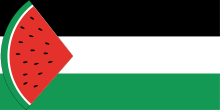


The watermelon is a symbol of Palestinians' public expression in protests and artworks, representing the struggle against the Israeli occupation of the Palestinian territories.[1][2][3][4][5]
YouTube Encyclopedic
-
1/2Views:18 1262 293
-
Watermelon as a symbol of Palestine #watermelon #palestine
-
paint them everywhere! #oilpainting #watermelon #palestine
Transcription
Origins
The Palestinian flag, coloured in the Pan-Arab colors of red, green, white and black, has historically been banned at times in Israel, leading to the locally-grown and similarly-coloured watermelon taking its place in Palestinian iconography as an alternative for decades.[6] Following the 1967 Six-Day War, Israel banned the display of the Palestinian flag and its colours in the Gaza Strip and the West Bank, and annexed East Jerusalem, with the Israeli army arresting anyone who displayed it.[7][8]
In 1993, as part of the Oslo Accords, Israel lifted the ban on the Palestinian flag.[9] At the time, The New York Times claimed "young men were once arrested for carrying sliced watermelons",[10] but Palestinian artist Sliman Mansour has cast doubt on the validity of these claims. A later editor's note to the article says "Given the ambiguity of the situation, The Times should either have omitted the anecdote or made it clear that the report was unconfirmed."[10] He remembers a conversation about it, but does not recall any actual watermelon iconography being used until 2007, when Khaled Hourani created an image for a "Subjective Atlas of Palestine" project. Other artists who have used the watermelon include Sarah Hatahet, Sami Boukhari, Aya Mobaydeen and Beesan Arafat.[11]
Resurgence
The watermelon symbol is experiencing a revival, with a growing number of individuals leveraging it, along with watermelon emojis, on various social media platforms.[12] This surge in usage coincides with the commencement of the Israel-Hamas conflict on October 7th.[13] Although "shadow banning," a practice wherein users' posts are concealed without their awareness, may be challenging to detect, advocacy and nonprofit groups focused on digital rights in the Middle East assert that they have observed clear biases, particularly on Meta platforms such as Facebook and Instagram. Online users are adopting this symbol to enhance the visibility of their voices and mitigate shadow banning. The watermelon symbol serves as a means to circumvent censorship on social media channels.[14]
See also
- List of national symbols of Palestine
- Kherson watermelon – Symbol of Ukrainian resistance to Russia
- Freedom pineapples – Political response to Chinese import ban
References
- ^ Holtermann, Callie (2023-12-27). "Why the Watermelon Emoji Is a Symbol of Support for Palestinians". The New York Times. Retrieved 2024-01-05.
- ^ "Watermelon: A slice of Palestinian resistance". Middle East Eye. 17 August 2022.
- ^ Sharon, Jeremy (21 June 2023). "Activists use watermelons to protest police crackdown on Palestinian flags". The Times of Israel.
- ^ Weldali, Maria (4 August 2021). "Watermelon becomes symbol of Palestinian existence, resistance". Jordan Times.
- ^ Hisham, Passant (19 October 2023). "How the watermelon symbolizes Palestinian resistance". Kuwait Times.
- ^ Berger, Miriam (12 July 2021). "Why Palestinians are uniting around watermelon emoji". Washington Post.
- ^ Sella, Adam (31 August 2023). "The fruits and vegetables of Palestine and their significance". Al Jazeera.
- ^ Chaves, Alexandra (30 May 2021). "How the watermelon became a symbol of Palestinian resistance". The National.
- ^ Syed, Armani (20 October 2023). "How the Watermelon Became a Symbol of Palestinian Solidarity". TIME.
- ^ a b Kifner, John (1993-10-16). "Ramallah Journal; A Palestinian Version of the Judgment of Solomon". The New York Times.
In the Gaza Strip, where young men were once arrested for carrying sliced watermelons—thus displaying the red, black and green Palestinian colors—soldiers stand by, blasé, as processions march by waving the once-banned flag
- ^ Chaves, Alexandra (2021-05-30). "How the watermelon became a symbol of Palestinian resistance". The National. Retrieved 2023-11-19.
- ^ Holtermann, Callie (2023-12-27). "Why the Watermelon Emoji Is a Symbol of Support for Palestinians". The New York Times.
- ^ Hassan, Jennifer; Berger, Miriam (November 16, 2023). "Why the watermelon is a symbol for the Palestinian cause". The Washington Post.
{{cite news}}: CS1 maint: date and year (link) CS1 maint: url-status (link) - ^ Giulia, Carbonaro (12 December 2023). "Meta's social media platforms are systemically censoring pro-Palestine content, NGO finds". Euro News Next.
